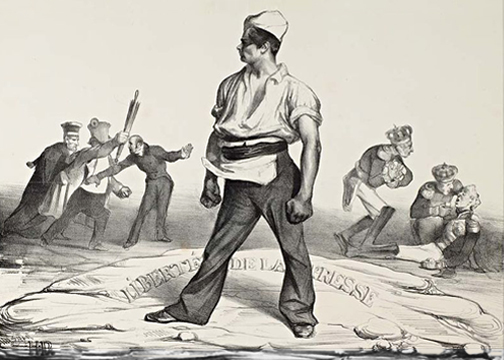Charles Philipon launched a new illustrated newspaper under the banner Le Charivari on December 1, 1832. Daumier was a contributor to Le Charivari from the beginning. Le Charivari would entertain the people of France in various forms until 1937. Philipon and his associate, Gabriel Aubert, along with contributors to the La Caricature and Le Charivari, were under constant threat from the censors up until 1835, when the government banned political caricature outright. The first cartoon Daumier contributed to Le Charivari was a cartoon titled “Un Héros De Juillet” (A July Hero) dated May 1831, published in Le Charivari December 15, 1832
Daumier squishes clay into faces
The publisher Philipon is credited with giving Daumier the idea of producing a series of oil painted clay sculptures of prominent Parisians to use as models in creating his caricatures for print. This effort eventually resulted in over 100 unbaked clay sculptures between 1832 and 1835. The first group now titled Célèbrités du Juste Milieu (Celebrities of the Juste Milieu) included about forty busts. Twenty-six represented members of French Parliament.These sculptures were later reproduced in plaster and bronze. Thirty-six of the original clay sculptures (alt) are on display at the Musée d'Orsay in Paris.
Atherton Curtis, in his book Some Masters Of Lithography, published by D. Appleton and Company in 1897, lists a number of Daumier's caricatures published in 1833 for special recognition: Mr. Pot de Naz, Mr. Sebast, Mr. Prune, Mr. Baill, and Mr. Keratr. Curtis wrote, “This last is especially remarkable.”
L’Association mensuelle, Daumier has a major impact
Many of Daumier's print series were re-published on high quality paper and sold on a subscription basis. In 1834 Charles Philipon published some of Daumier's most popular cartoons as extra large prints in a series titled L’Association mensuelle (Association Mensuelle). This series of 20 lithographs is one of the most renown set of caricatures by Daumier. Here are four of the most important images in the series.
“Le Ventre L'gislatif” (alt) (The Legislative Belly) shows the legislative Chamber of Deputies of 1834 with 35 of the best known members.
“Ne vous y frottez pas” (alt) (Don't You Meddle With It!) features a printer ready to defend the freedom of the press against the monarchs.
“Enfoncé Lafayette!... Attrappe, Mon Vieux!” (alt1) (alt2) (Crushed Lafayette!... Trapped, Old Fellow!) depicts Louis-Philippe pretending to weep at the death of La Fayette.
In The History Of The Nineteenth Century In Caricature by Arthur Bartlett Maurice And Frederic Taber Cooper published in London by Grant Richards In 1904, Maurice and Cooper single out this one cartoon as Daumier's most famous work about Louis-Philippe.
La Rue Transnonain(alt1) (alt2) represents a massacre of silk weavers by the National Guard in Rue Transnonain. This lithograph was censored after the fact. The prints were confiscated and the stone destroyed.
Elisabeth Luther Cary claims Daumier created some of his most powerful caricatures in the years immediately following his release from captivity. During this period his skills and passion for political cartooning were at their pinnacle and he focused that creative force on public figures including King Louis-Philippe, politicians and other government officials. Cary extols the virtue of “Mr. Barbe Marbois”, which was published in La Caricature on May 28, 1835, as one of the “most beautiful products of this period” and exhibiting “unimpeachable gravity of great art.” This cartoon features François Barbé-Marbois, the 90 year old judge who presided over the trial of the leaders of the April 1835 uprising and who orchestrated the ban on caricature.
France instituted extremely oppressive censorship laws in 1835. This effectively made political caricatures illegal. Daumier, with some relief, shifted the focus of his caricature from politics to more commentaries on general French culture.
Daumier Picks Up a Brush
Daumier began painting in the mid 1830's and by the end of the decade was very dedicated to producing more oils and watercolors. He had more interest in painting than in caricature and lithography, but he found it necessary to keep producing cartoons in order to have income. His paintings are now well regarded, but at the time of their creation they were largely unappreciated. His paintings did not start increasing in value until after his death. Daumier painted about 500 paintings in oil and watercolor on a variety of subjects including many portraying Don Quixote and Sancho Panza.
Robert Macaire charms Paris
One of the successful collaborations between Philipon and Daumier is the Robert Macaire series, published between 1835 and 1839, based on a character from French theater. Macaire represented bourgeois society in the form of an irrepressible, unprincipled rascal. He was partnered with Bertrand, his less brilliant accomplice and the frequent recipient of the short end of any stick. The series was published in Le Charivari and also in book format such as Les cent et un Robert-Macaire. The Robert Macaire series is also available on The Daumier Register.
In the next post in this series Honoré Daumier marries after the birth of his son
NEXT - Honoré Daumier Part 3





